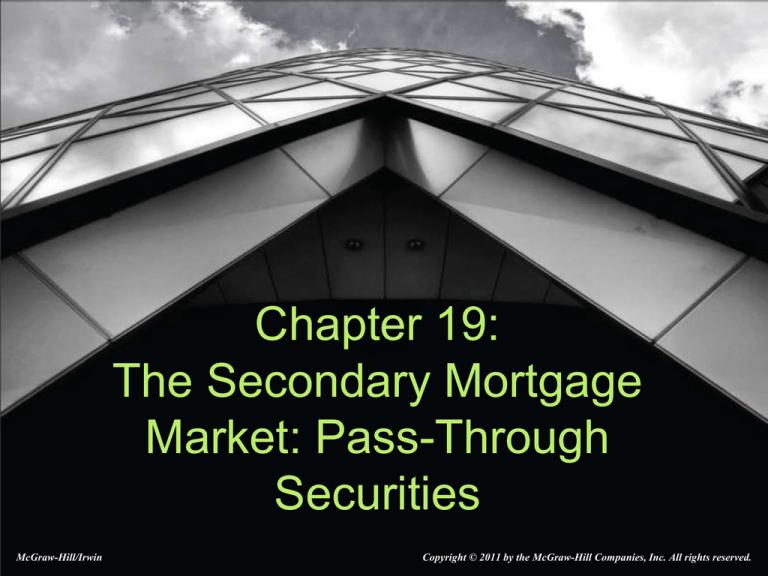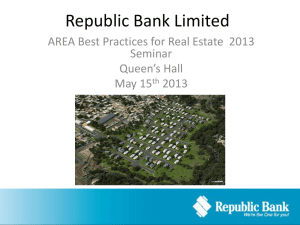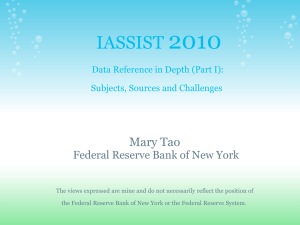
Chapter 19:
The Secondary Mortgage
Market: Pass-Through
Securities
McGraw-Hill/Irwin
Copyright © 2011 by the McGraw-Hill Companies, Inc. All rights reserved.
Secondary Mortgage Market
Allows originators to replenish funds
Facilitates geographic flow of funds
Provides an investment option for savers
Early buyers of mortgages
– Mortgage companies and thrifts
FHA insurance and VA guarantees
– Minimum underwriting standards
19-2
Secondary Mortgage Market
1954 Charter Act: FNMA or “Fannie Mae”
– Enhance secondary market operations
FHA and VA mortgages
–
–
–
–
–
–
Manage prior direct loans
Manage special assistance programs
FNMA transforms into a private organization
FNMA issues securities
The “Treasury backstop”
As of 2008, Fannie Mae is under government control
19-3
Secondary Mortgage Market
HUD Act 1968: GNMA or “Ginnie Mae”
– GNMA manages and liquidates FNMA loan
portfolio
– Special assistance functions
– Guarantee timely payment of principal and
interest for FHA-VA mortgage pools
– Eliminated any default delay in payments to
investors. This led to virtual explosion in
secondary market and rise of pass-through
securities
19-4
Secondary Mortgage Market
Emergency Home Finance Act 1970: FHLMC or
“Freddie Mac”
–
–
–
–
Provide a secondary market for conventional loans
Allowed FNMA to purchase conventional mortgages
FHLMC allowed to purchase FHA and VA mortgages
Fannie Mae and Freddie Mac compete for all
mortgage loans but they do tend to still focus on their
original lines of business
– As of 2008, Freddie Mac is under government control
19-5
Exhibit 19-1
Funds Flow Analysis (direct purchase programs)
19-6
Secondary Mortgage Market
Operation
– Direct Sale Programs
Mandatory Commitment
Optional Delivery
Mortgage-Related Security Pools
– Securitization
19-7
Secondary Mortgage Market
1.
2.
3.
4.
In this chapter and the next, we’ll cover
the major types of mortgage-backed
securities including:
Mortgage-backed bonds (MBBs)
Mortgage pass-through securities (MPTs)
Mortgage pay-through bonds (MPTBs)
Collateralized mortgage obligations
(CMOs)
19-8
Exhibit 19-3
Mortgage Pass-Through Securities: Issuance and Funds
Flow
19-9
Secondary Mortgage Market
Mortgage-Backed Bonds
– Issuer retains ownership of mortgages
– Mortgages held in trust
– Fixed coupon rate
– Specific maturity
– Over collateralization
– Mark to market
19-10
Secondary Mortgage Market
Mortgage-Backed Bonds
– Investment Rating
Mortgage Quality
Geographic Diversification
Interest Rates on Mortgages
Prepayment Probability
Over collateralization
Appraised value and debt coverage ratio if
commercial mortgages
19-11
Secondary Mortgage Market
Mortgage-Backed Bonds
– Example 19-1: Mortgage Bond Valuation
– 20-year to maturity
– Par value of $10,000
– 10.5% annual coupon.
– At issue, bond market investors require an
11% interest rate.
– What is the initial price of the bond?
19-12
Secondary Mortgage Market
Mortgage-Backed Bonds
– Example 19-1:
FV = $10,000
n
PMT
i
CPT
= 20
= .105 x $10,000 = $1,050
= 11
PV
= $9,601.83
19-13
Secondary Mortgage Market
Mortgage-Backed Bonds
– In Example 19-1, what would be the price of
the bond 5 years later if investors required a
12% return?
– n is 15 years
– i is 12%
19-14
Secondary Mortgage Market
Mortgage-Backed Bonds
– Example 19-1:
FV = $10,000
n
= 15
PMT = $1,050
i
CPT
= 12
PV
= $8,978.37
19-15
Secondary Mortgage Market
Mortgage-Backed Bonds
– Zero-Coupon Bond
The only cash flow to an investor is a lump sum at
maturity
No interim coupon payments
Also called “deep discount” bonds
Analysis is just computing the present value of a
lump sum
19-16
Secondary Mortgage Market
Mortgage Pass-Through Securities
– Ownership interest in a pool of mortgages
– Trustee is owner of the mortgages in the pool
– Principal and interest are passed through
– Servicing and guarantee fees
19-17
Secondary Mortgage Market
Mortgage Pass-Through Securities
– Issuers & guarantors
– Default insurance
– Payment patterns and security
– Coupon rate and interest rates
– Seasoned mortgages
19-18
Secondary Mortgage Market
Mortgage Pass-Through Securities
– Number of mortgages
– Geographic distribution
– Borrower characteristics
– Loan prepayment
– Nuisance calls
19-19
Secondary Mortgage Market
General Pricing of MPTs
– Interest Rate Risk
– Default Risk
– Risk of Delayed Payment of Principal and
Interest
As of 2008, Ginnie, Fannie, and Freddie are all
under government control
– Prepayment Risk
19-20
Secondary Mortgage Market
General Pricing of MPTs
– Coupon rate vs. yield to maturity
– Servicing Fee
– Weighted Average Coupon (“WAC”)
– Stated Maturity Date
– Weighted Average Maturity
– Payment Delays
– Pool Factors
19-21
Secondary Mortgage Market
Example 19-2:
– A mortgage pool consists of the following:
$500,000 of 30-year 7% Fixed Rate Mortgages
$200,000 of 29-year 6.5% Fixed Rate Mortgages
$300,000 of 28-year 6% Fixed Rate Mortgages
– What is the weighted average coupon and
average maturity of the mortgage pool? If
there is a servicing fee of .5%, what is the
quoted maturity and quoted coupon rate?
19-22
Secondary Mortgage Market
Example 19-2:
Amount
Maturity
Interest
Rate
Weight
WxM
WxI
$500,000
30
7%
.5
15
3.5
$200,000
29
6.5%
.2
5.8
1.3
$300,000
28
6%
.3
8.4
1.8
$1,000,000
WAM = 29.2 WAC = 6.6
Quoted Maturity = 30 Years
Quoted Coupon Rate = 6% - .5% = 5.5%
19-23
Secondary Mortgage Market
Pricing Issues
– Mortgage-Backed Bonds
Specified maturity
Specified coupon payment and face value
Pricing methodology is relatively straight forward
– MPTs
Cannot define a specific maturity
Cannot define specific cash flows
Pricing is based on prepayment assumptions
19-24
Secondary Mortgage Market
Prepayment Assumptions
– Average Maturity Assumption
– Constant Prepayment Rate Assumption
– FHA Prepayment Experience
– PSA Prepayment Model
Convexity
– Price Compression
19-25








